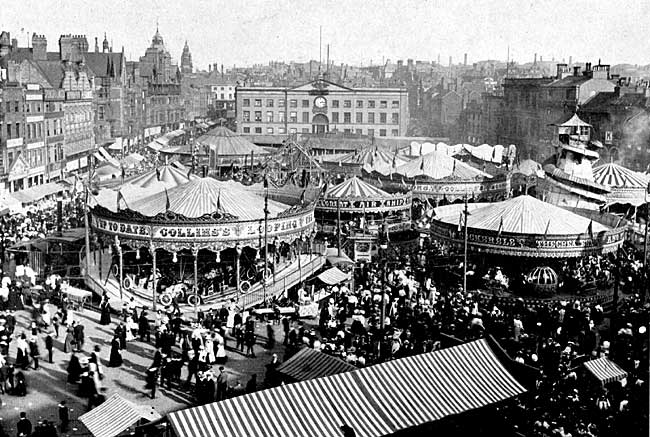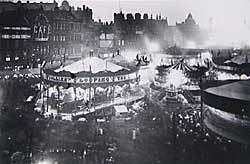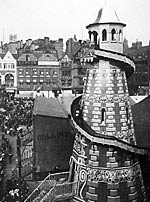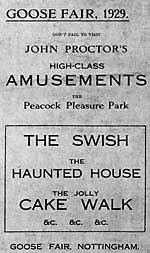
Overview

Goose Fair, 1908.
The Nottingham Goose Fair goes back some 1000 years. It is one of the biggest and the most well known fairs. Its origins are not, contrary to belief, based on geese but was a Goods Fair held to stock up before the onset of winter. Henry II granted a charter in the 1160s with a right to hold a fair for eight days starting on the feast day of St Matthew on 21st September and was granted to the Priory of Lenton, who were a very powerful landlord at that time.
In 1230, Henry III added four more days to the Lenton Fair which gave more revenue to the Church and Lenton Church was more important than Nottingham at this time. Nottingham’s Fair took second place to the Lenton fair and there were many disputes between the Church and the Nottingham Corporation over the importance of the two fairs as Nottingham was a borough of some importance with a large trading centre.
During the reign of Edward I (1272-1307) various charters were granted and increasing the size and status of the Fair. In 1284 a charter was granted which mentioned the existing St Matthew’s fair and granted a new one to be held over 15 days beginning on the eve of St Edmund’s day on 20th November, who was the patron saint of England before St George. A charter granted to the town of Nottingham in 1290 refers to the fair which then continued over 21 days.
The Lenton Fair, during this time, was very much for re-stocking of goods, as well as the sale of local produce. Goods such as gold, leather, fish and fine clothes were recorded by the Lenton Priory in 1538.
In 1541 the fair now became known as Goose Fair. The first mention of the fair as such is in the account of John Truswell, steward of Wollaton Hall (the old Hall by the church not the present day building), where he purchased a pair of breeches for 1s10d. During the middle of the 16th century some people thought only geese were sold at the fair! The geese were walked great distances to the fair, some 20,000 from the Lincolnshire fens and would have their feet tarred to make the walk easier! It would appear that by this time the original Lenton Fair had been moved into Nottingham and in 1579 the Mickleton Jury (the jury of court leets) requested that wooden stalls to be erected around the Market Square, which was cobbled, to bring in more revenue.
In 1634 a resolution was passed for the Mayor, Sheriff and Aldermen to formally attend and read out the proclamation to and to ring bells officially open the fair. The Sheriff had a right to choose what he wanted from the stalls.
The fair was still held on 21st September whenever possible, but there were occasions when it had to be changed: during 1300-1400 when leprosy came to England; during 1346 when the Black Death was particularly virulent and again when the plague struck in 1646. Strangely enough during the English Civil War the fair continued but was held in Lenton.
In 1752 there was a change of calendar. The Gregorian calendar was not fully adopted in Great Britain until then because of religious differences. Where the Roman Catholic countries were quick to adopt the new calendar, it was initially rejected by Protestant states. The fair was still held but moved to begin on 2nd October to fit in with the Sessions Court and lasted for one week until 1875.
During the 1760s great numbers of cattle and horses were recorded as being sold at the fair. It would seem that geese were not as popular as believed and in fact cheese was more important in the diet of the population. A riot occurred in 1766 over the high cost of cheese and constables had to patrol the fair.
By the end of 18th century the Goods Fair had changed and was no longer one of solely buying and selling produce. New attractions were to be seen including Madame Tussaud; wild animals; theatricals including dwarfs, fat ladies and gypsy singers. Nevertheless the idea of the sale of goods still continued with four stalls being erected at the front of the Exchange Building selling locally produced goods including lace and hosiery, willow baskets, whipcords and liquorice.
The fair was still held in the Old Market Square but in 1876 it was reduced from 8 to 5 days beginning on the first Thursday of October and then in 1880 it was cut again to two and half days, beginning at 12 noon on the Thursday. However, it was coming under severe criticism as being dirty, noisy as well as increasing intemperance. There were accusations of large number of pick pockets, beggars and prostitutes being attracted by the fair. In 1877 a resolution was passed by the Goose Fair Inquiry Committee, Town and Social Guild, to collect and tabulate evidence as to the moral, social, sanitary and commercial effect of the fair on the town. The Council’s answer was that it made a lot of money for them; £702.11d in rent! By 1977 this had risen to £3036, 00.
Whilst the fair was held in the Market Square many of the adjacent roads were taken over by travelling people all eager to sell their wares. The Theatre Royal also put on performances to attract fair goers. The local railways put on special excursions to deal with the crowds.

Goose Fair at night, 1910. Photograph courtesy of The National Fairground and Circus Archive, University of Sheffield.
Over the years since the nineteenth century the number and disparity of attractions has changed considerably. During this time performing fleas, Wombwells wild animals and Contrells swimming show was all part of the attractions. However, steam power gave the go-ahead for an invasion of bigger rides. In 1906 the first helter skelter, Big Wheel and roundabouts with motor cars were seen at the fair. The following year the cake-walk first made its appearance (so named after an African dance – the Cacka).
1927 was the last year the fair was held on the Old Market Square and it was also the last year that livestock was sold. At the end of the fair the Square was formally landscaped and the following year the fair was moved to the Forest – much to the annoyance of over 12000 people who protested about the move.
During the two world wars, 1914-1918 and 1939-1945 no fairs were held. Today the fair is visited by thousands of people during the first full weekend of October each year. The fair is opened at midday on Thursday by the City dignitaries and closes at midnight on the Saturday. There are over 500 rides and 70 sideshows and over the years has attracted many famous artistes such as Madame Tussaud and Richard Chipperfield. The fair has featured every ride and amusement which has ever taken to the road.
- Official Goose Fair website
- Features on various aspects of the Goose Fair available on BBC Nottingham's website
Cartographic
Nottinghamshire Archives
- CA/TC 10/128/8 - File 11E: Forest - Exhibitions, Circus Sites etc April 1953 - March 1961
- Plan showing Goose Fair site, The Forest 1950 - Scale 1:2500
Graphic
Photographic
Picture the Past is a joint project by the local authorities of Nottingham, Nottinghamshire, Derby and Derbyshire, to conserve and make publicly accessible the photographic heritage of the North East Midlands. It has a large selection of photographs of Goose Fair:

Goose Fair in 1914. Photograph courtesy of The National Fairground and Circus Archive, University of Sheffield.
The National Fairground and Circus Archive, based at the University of Sheffield, holds a large number of photographs depicting Goose Fair:
Film and video
The Nottinghamshire Local Studies Library at the Central Library in Nottingham has a large number of videos and DVDs depicting Goose Fair. Search the online library catalogue with the term "goose fair":
Artistic
Nottinghamshire Archives:
- XPR 14/6 - Folder 4 - Goose Fair (n.d.)
- XPR 15/3 - Folder 15 - Goose Fair (n.d.) by Hammond, T. W., Chapel Bar during Goose Fair (photographed from drawing)
- XPR 15/3 - Folder 15 - Goose Fair (n.d.) by Hammond, T. W., Long Row during Goose Fair (photographed from drawing)
Castle Museum and Art Gallery
- Noel Denholm Davis “Nottingham Goose Fair” (Ref no1957-4)
- Thomas Cooper Moore “Goose Fair, Beastarket Hill” (Ref no 1919-13)
- Sheila robinson “Goose fair Ref no 1961-62
Archival/written
Nottinghamshire Archives:
- CA/TC 10/126/13/1 - File 40: Draft Minutes Aug 1960-Jul 1961 includes report on 1960 Goose Fair
- CA/TC 10/126/2 - File 10: Goose Fair Sep 1937-Sep 1945 ( Includes list of rides and sideshows for 1938 fair with rents paid and list of rides and sideshows accepted for the 1945 fair; Details of summer Goose Fair held in 1944 as part of 'Holidays at Home' scheme and cancelling of 1939 fair due to the outbreak of war; Use of Goose Fair site for Air Defence purposes (1940)
- CA/TC 10/126/13/1 - File 40: Draft Minutes Aug 1960-Jul 1961 includes report on 1960 Goose Fair
- 32q - Transcripts of Records of the Borough of Nottingham c.1155-1900 (in 9 volumes)
- NA. 98 - Transcripts of the Sidney Race Diaries (1890-1952) available in our Reference Library contain several first hand accounts of visits to Goose Fairs (9 volumes)
Printed

Goose Fair flier, 1929.
Primary
Nottingham Local Studies Library, Central Library, Nottingham
- There is a selection of newspaper articles held at the library covering a wide period of time
- Has a selection of ephemera relating to Goose Fair.
Nottinghamshire Archives
- DD/CH 45/2 - The Nottingham Review 15 Oct 1830 - Reference to arrest under 'Police Office' column, page 3
- CD-ROM - Nottingham Date Book Vols 1 & 2 (850-1884)
- DD 1168/24/28 - Menu for Goose Fair luncheon at Exchange Hall (1925)
- DD 1168/24/41 - Menu for Goose Fair luncheon at the Guildhall (1926)
- DD 1168/24/58 - Invitation to opening of Goose Fair (1933)
- DD 1937/6 - Poster for Nottingham Goose Fair (1975)
Museum of Nottingham Life
- A few small items of ephemera.
Secondary
- [Bonnell, C.] R. Fleeman & Sons Limited, A 1 Popular History of Nottingham Goose Fair, and "The Goose Fair Garland". Compiled by "Bon-Bon". [Nottingham], Fleeman, [1904]. 30 p., ill.
- Denison, G. M. 'Nottingham's Goose Fair', Nottingham Observer, 2, 18 (1957), 48-49, ill.
- Hanna, M. 'Those Were the Days', Fairground Mercury, 7, 3 (1984), [7]-[13].
- Lund, B. Goose fair in old picture postcards, Keyworth, Reflections of a bygone age, 2005
- Iliffe, R. and Baguley, W. Victorian Nottingham, 4 (1971). 'Goose Fair', [5]-[69].
- Iliffe, R. and Baguley, W. Old Nottingham Goose Fair: A Story in Pictures. Nottingham Historical Film Unit, 1979. 47 p.
- Manning, I. 700 Years of Goose Fair. Nottingham, T. Bailey Forman, 1994. 114 p. Mainly pictorial.
- Nottingham Historical Film Unit. In Retro: Nottingham Goose Fair. Oldham, Ronam, 1973. [64] p. Mainly pictorial.
- Storr, J. and Storr, D. 'Nottingham Goose Fair, 1970', Lore and Language, 6 (1972), 10-12.
- Wilkes, P. The Great Nottingham Goose Fair. Burton-on-Trent, Trent Valley Publications, 1989. 56 p., ill.